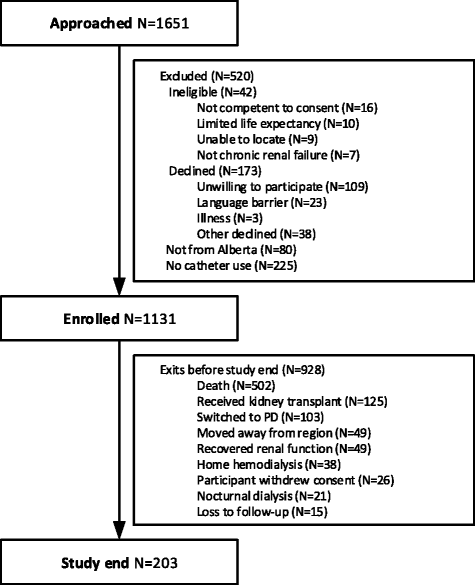Catheter-related blood stream infections in hemodialysis patients: a prospective cohort study
- PMID: 29221439
- PMCID: PMC5723103
- DOI: 10.1186/s12882-017-0773-5
Catheter-related blood stream infections in hemodialysis patients: a prospective cohort study
Abstract
Background: For people requiring hemodialysis, infectious mortality is independently associated with geographic distance from a nephrologist. We aimed to determine if differential management of catheter-related blood stream infections (CRBSIs) could explain poorer outcomes.
Methods: We prospectively collected data from adults initiating hemodialysis with a central venous catheter between 2005 and 2015 in Alberta, Canada. We collected indicators of CRBSI management (timely catheter removal, relapsing bacteremia); frequency of CRBSIs; hospitalizations; predictors of CRBSIs, and bacteremia. We evaluated indicators and infectious episodes as a function of the shortest distance by road to the closest nephrologist's practice: <50 (referent); 50-99; and ≥100 km.
Results: One thousand one hundred thirty-one participants were followed for a median of 755 days (interquartile range (IQR) 219, 1465) and used dialysis catheters for a median of 565 days (IQR 176, 1288). Compared to the referent group, there was no significant difference in the rate ratio (RR) of CRBSI in the 50-100 and >100 km distance categories: RR 1.63; 95% confidence interval (CI) (0.91, 2.91); RR 0.84 (95% CI 0.44, 1.58); p = 0.87, respectively or in bacteremia: RR 1.42; (95% CI 0.83, 2.45); RR 0.79 (95% CI 0.45,1.39) p = 0.74, respectively. There were no differences in indicators of appropriate CRBSI management or hospitalizations according to distance. The overall incidence of CRBSIs was low (0.19 per 1000 catheter days) as was the frequency of relapse. Only liver disease was independently associated with CRBSI (RR 2.11; 95% CI 1.15, 3.86).
Conclusions: The frequency and management of CRBSIs did not differ by location; however, event rates were low.
Keywords: Bacteremia; Catheter; Hemodialysis; Residence location.
Conflict of interest statement
Ethics approval and consent to participate
Written informed consent was obtained from participants and research ethics boards of the Universities of Alberta and Calgary approved the study.
Consent for publication
Not applicable.
Competing interests
The authors declare that they have no competing interests.
Publisher’s Note
Springer Nature remains neutral with regard to jurisdictional claims in published maps and institutional affiliations.
Figures
Similar articles
-
Adverse Outcomes After Tunneled Dialysis Catheter-Related Bloodstream Infections-Too Dark at the End of This Tunnel?Semin Dial. 2025 Mar-Apr;38(2):124-131. doi: 10.1111/sdi.13232. Epub 2024 Dec 5. Semin Dial. 2025. PMID: 39639380
-
Cathasept Line Lock and Microbial Colonization of Tunneled Hemodialysis Catheters: A Multicenter Randomized Controlled Trial.Am J Kidney Dis. 2015 Dec;66(6):1015-23. doi: 10.1053/j.ajkd.2015.04.047. Epub 2015 Jun 30. Am J Kidney Dis. 2015. PMID: 26141306 Clinical Trial.
-
Linezolid versus vancomycin antibiotic lock solution for the prevention of nontunneled catheter-related blood stream infections in hemodialysis patients: a prospective randomized study.Semin Dial. 2012 May;25(3):344-50. doi: 10.1111/j.1525-139X.2011.00965.x. Epub 2011 Nov 10. Semin Dial. 2012. PMID: 22074188 Clinical Trial.
-
Current Concepts in Hemodialysis Vascular Access Infections.Adv Chronic Kidney Dis. 2019 Jan;26(1):16-22. doi: 10.1053/j.ackd.2018.10.005. Adv Chronic Kidney Dis. 2019. PMID: 30876612 Review.
-
Bedside Tunneled Dialysis Catheter Removal-A Lesson Learned From Nephrology Trainees.Artif Organs. 2017 Sep;41(9):810-817. doi: 10.1111/aor.12869. Epub 2016 Dec 26. Artif Organs. 2017. PMID: 28025835 Review.
Cited by
-
The epidemiology and microbiology of central venous catheter related bloodstream infections among hemodialysis patients in the Philippines: a retrospective cohort study.BMC Nephrol. 2024 Oct 2;25(1):331. doi: 10.1186/s12882-024-03776-8. BMC Nephrol. 2024. PMID: 39358687 Free PMC article.
-
Epidemiology of haemodialysis outcomes.Nat Rev Nephrol. 2022 Jun;18(6):378-395. doi: 10.1038/s41581-022-00542-7. Epub 2022 Feb 22. Nat Rev Nephrol. 2022. PMID: 35194215 Free PMC article. Review.
-
REDUcing the burden of dialysis Catheter ComplicaTIOns: a National approach (REDUCCTION) - design and baseline results.Kidney360. 2020 Jun 2;1(8):746-754. doi: 10.34067/KID.0001132020. eCollection 2020 Aug 27. Kidney360. 2020. PMID: 35372959 Free PMC article. Clinical Trial.
-
An updated review on application of 3D printing in fabricating pharmaceutical dosage forms.Drug Deliv Transl Res. 2022 Oct;12(10):2428-2462. doi: 10.1007/s13346-021-01074-6. Epub 2021 Oct 6. Drug Deliv Transl Res. 2022. PMID: 34613595 Review.
-
Catheter-Related Blood Stream Infections and Associated Factors Among Hemodialysis Patients in a Tertiary Care Hospital.Infect Drug Resist. 2023 May 22;16:3145-3156. doi: 10.2147/IDR.S409400. eCollection 2023. Infect Drug Resist. 2023. PMID: 37249964 Free PMC article.
References
-
- Lin G, Allan DE, Penning MJ. Examining distance effects on hospitalizations using GIS: a study of three health regions in British Columbia, Canada. Environ. Plan. London: A. SAGE PublicationsSage UK; 2002. pp. 2037–2053.
-
- Clark RA, Driscoll A, Nottage J, McLennan S, Coombe DM, Bamford EJ, et al. Inequitable provision of optimal services for patients with chronic heart failure: a national geo-mapping study. Med J Aust. 2007;186:169–173. - PubMed
MeSH terms
Grants and funding
LinkOut - more resources
Full Text Sources
Other Literature Sources
Medical


